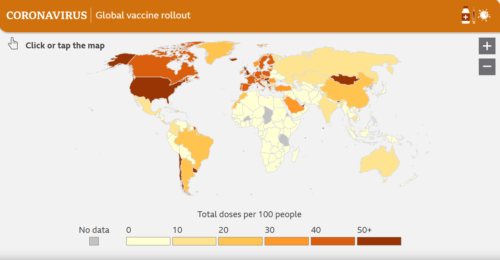Covid-19 is continuing to spread around the world, with more than 160 million confirmed cases and three million deaths across nearly 200 countries. The US, India and Brazil have seen the highest number of confirmed cases, followed by France, Turkey, Russia and the UK. Very few places have been left untouched. Several coronavirus vaccines have been approved for use, either by individual countries or groups of countries, such as the European Union and the World Health Organization (WHO).
Current vaccination statistics:
Of the 189 countries and territories administering vaccines and publishing rollout data, 66 are high-income nations, 100 are middle-income and 23 low-income. Overall, China and the US have given the most doses, with about 409 million and 274 million respectively, while India has administered more than 182 million so far. If use doses per 100 people in countries with a population of at least one million, Israel and the United Arab Emirates are at the top of the list.
The map below, using figures collated by Our World in Data – a collaboration between Oxford University and an educational charity – shows the total number of doses given per 100 people, mostly first doses.

Some countries have secured more vaccine doses than their populations need, while other lower-income countries are relying on a global plan known as Covax, which is seeking to ensure everyone in the world has access to a vaccine. The Covax program is currently 140 million doses short because of India’s continuing COVID crisis. The Serum Institute of India (SII), the largest single supplier to the Covax scheme, has made none of its planned shipments since exports were suspended in March.
If we look at the current trending, the coronavirus pandemic grew worse in March, as new cases have increased in Europe and South America. As countries open and lift restrictions this trend could also continue. It is largely dependent upon the governments’ supply chain management in country and contract negotiations for number of doses purchased.
Recently, both the Moderna and Pfizer vaccines have been approved for children ages 12-17 years old. This could allow for more of each country’s populations to be vaccinated. This age groups vaccination rate will be greatly dependent on each country’s vaccination timeline and the accessibility/supplies of the vaccines.
Footnotes: https://www.nytimes.com/interactive/2020/world/coronavirus-maps.html